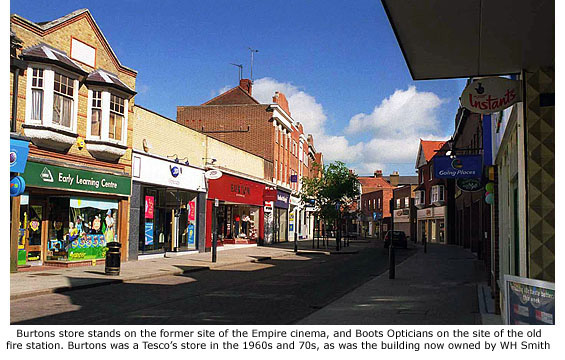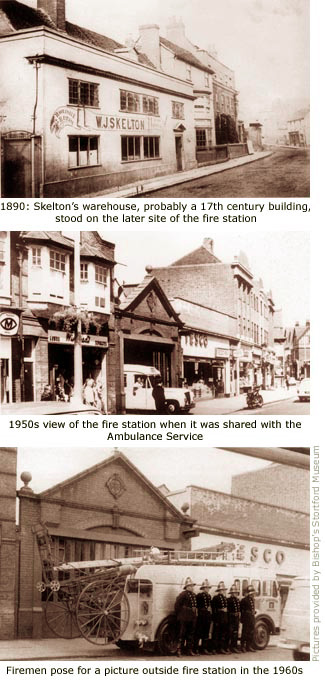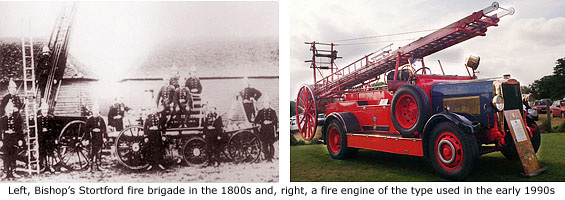|

The site of Bishop's Stortford's first official fire station, built in 1898, is currently occupied by Boots Opticians at No 22 South Street. A private fire brigade had existed in the town prior to this date, but we have to go back to the Roman occupation of Britain to understand the history of fire fighting in this country.
Like everything the Romans did, fire fighting was an organised business. They first used bands of slaves known as 'Familia Publica' but, for obvious reasons, their less than enthusiastic approach to the task proved ineffective. Citizens' complaints to the authorities always fell on deaf ears, but when a quarter of Rome was burned to the ground in 6 AD, the Emperor Augustus took it upon himself to establish a highly trained fire brigade called the 'Corpes of Vigiles'. Their fire fighting methods proved so effective they were used throughout the Roman Empire for the next 400 years, but when the Romans left Britain early in the 5th century they took their skills with them. For the next 1200 years, Britons tackled fires by passing leather buckets hand to hand.
The Saxons gave little thought to fire prevention, or fire fighting, but as most dwellings were built of wood and thatch, laws put in place after the Norman Conquest required that all internal house fires should be extinguished at night-fall. This was usually done by putting a metal cover over the open hearth. The French word for this cover was Couvre Feu, which in Middle English became Curfew. This gave rise to the Curfew Bell that rang in towns and cities long after its original purpose had been forgotten. The only other enforcible fire regulation was that householders should keep a vessel of water outside their front door in summer when the risk of fire was at its highest.
|
|
England's biggest conflagration in the Middle Ages was the first fire of London in 1212, in which at least 3000 people died. But even then little effort was put into organised fire fighting. Not until the start of the 17th century did fire regulations require that fire fighting equipment for general use should be kept in the parish church. In the event of a fire, a churchwarden was to assume command and it was he who organised and supervised the bucket passing. They also had hand squirts (pumps that were of little or no use) and firehooks for pulling down buildings to make a firebreak. Unfortunately, such equipment did little to stem the Great Fire of London in 1666. Organisation and fire fighting skills certainly improved after this disasterous event, but there was still no revolutionary device available with which to fight fires.
 In 1667, property developer Dr Nicholas Barbon (1640–1698) offered the first fire insurance, and in 1680, to cut the cost of any claims, formed his own fire brigade to extinguish fires at the premises of his policyholders. The company he formed became known as the Phoenix fire office. Others followed his lead and by the 1720s fire insurance was being offered by at least twelve companys, each with their own fire brigade dressed in distinctive colours. In 1667, property developer Dr Nicholas Barbon (1640–1698) offered the first fire insurance, and in 1680, to cut the cost of any claims, formed his own fire brigade to extinguish fires at the premises of his policyholders. The company he formed became known as the Phoenix fire office. Others followed his lead and by the 1720s fire insurance was being offered by at least twelve companys, each with their own fire brigade dressed in distinctive colours.
To identify a property covered by insurance, each company would fix its own firemark, made of copper or lead, to the outside of the building. This bore the symbol of the insurance company as well as a policy number. Local examples of firemarks can be found in Basbow Lane (See Guide 3) and Portland Road (See Guide 14).
Fires were attended by any brigade that happened to be in the vicinity when the alarm was raised, but no attempt would be made to put out the fire if the burning premises wasn't insured with their company. Nor would any assistance be given to the brigade who's company it was insured with.
The first effective water pump, introduced to this country in 1721, was based on a pump used in Europe since the late 1600s. Manually operated these pumps were difficult to work, but for a reward of one shilling (5p) members of the public would usually assist with the task. A further inducement to help was free refreshment, each fire engine carrying a large supply of beer for this purpose.
The first municipal brigade was set up in the city of Edinburgh in 1824 after independent fire brigades inadequately tackled several major fires there. London followed in 1833 when ten insurance companies amalgamated to form one brigade for the capital, called the London Fire Engine Establishment. The brigade continued to be run by insurance companies until it was taken over by the authorities in the mid 1960s.
During the 18th and 19th century, county councils, boroughs and parishes all formed their own fire brigades, backed up by volunteer brigades. Bishop's Stortford's Volunteer Fire Brigade, formed in June 1880, kept two horse-drawn engines at the Engine Station in South Street – a barn-like building that stood opposite the site where the new fire station was built in 1898. The key to this was held at the police station, from which each volunteer's home was connected by electric bell. In 1888 the brigade came under the direct control of the Bishop's Stortford Local Board, who had been in charge of local affairs since 1867. The old Engine Station was later used as a seed merchants shop, but demolished in the 1960s to make way for Sainsburys supermarket.
In the late 19th century manual pumps were replaced by steam pumps, and they in turn were replaced by motorised engines in the early 1900s. Perhaps through lack of funding, the town's volunteer brigade were still using horse-drawn steam pumps when fire destroyed Anchor Maltings in 1907 (See Guide 11).
In 1935, volunteer fireman James Hart, licencee of the Royal Oak at Apton Road, was tragically killed when he fell from a new Leyland fire engine being used on a trial run. In his memory a similar engine, known as Firefly, became unique in the fact that it was painted entirely black and operated in Bishop's Stortford between 1935 and 1948.
For the duration of the Second World War the National Fire Service was created to provide for better distribution of men and standardisation of equipment, but in 1947 control reverted back to local authorities. County and county borough brigades replaced autonomous town and village brigades, and Bishop's Stortford's fire service was taken over by the Herts Fire Brigade in 1948.
The fire station at No 22 South Street was later shared with the Ambulance Service, its entrance widened to accommodate both types of emergency vehicle. But with limited space this arrangement proved impracticable and in 1970 the station closed. Both services then moved to a new site at Patmore Road and the county council sold the building in South Street the following year. MORE PICTURES
|





 In 1667, property developer Dr Nicholas Barbon (1640–1698) offered the first fire insurance, and in 1680, to cut the cost of any claims, formed his own fire brigade to extinguish fires at the premises of his policyholders. The company he formed became known as the Phoenix fire office. Others followed his lead and by the 1720s fire insurance was being offered by at least twelve companys, each with their own fire brigade dressed in distinctive colours.
In 1667, property developer Dr Nicholas Barbon (1640–1698) offered the first fire insurance, and in 1680, to cut the cost of any claims, formed his own fire brigade to extinguish fires at the premises of his policyholders. The company he formed became known as the Phoenix fire office. Others followed his lead and by the 1720s fire insurance was being offered by at least twelve companys, each with their own fire brigade dressed in distinctive colours.